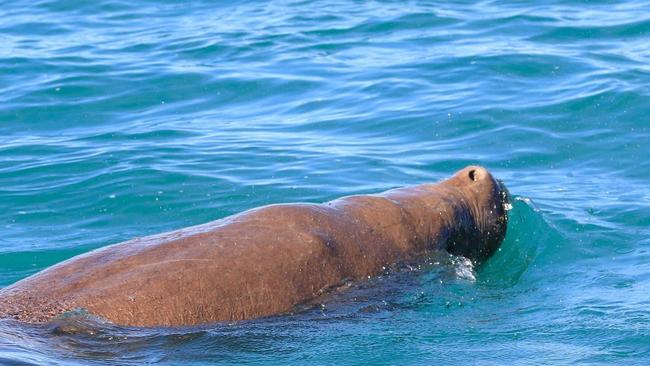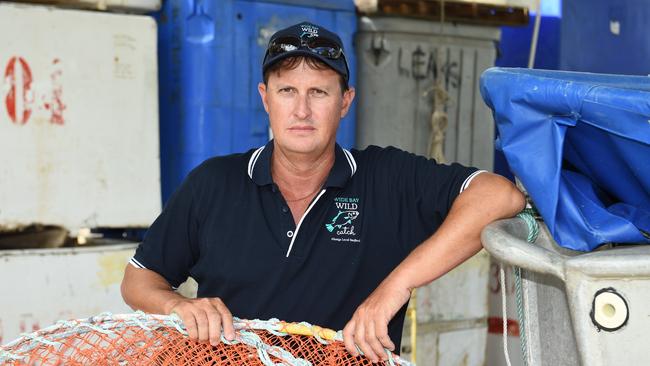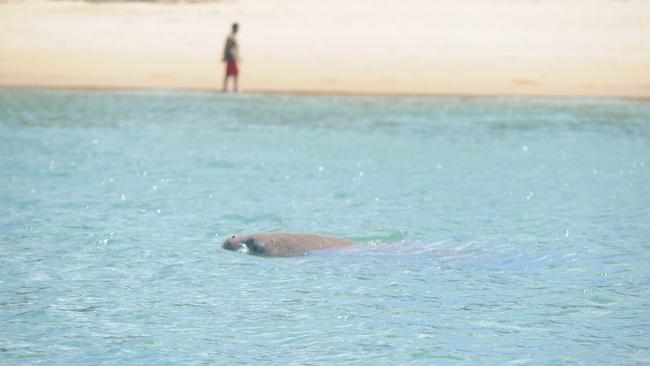Mary River floods: Seagrass killed in Great Sandy Marine Park
Research has revealed the staggering impact recent floods had on the Great Sandy Strait’s seagrass, sparking fears for the future of dugongs and turtles and fuelling an ongoing battle between commercial and recreational fishers.
Fraser Coast
Don't miss out on the headlines from Fraser Coast. Followed categories will be added to My News.
Back-to-back flooding events in the Mary River has had a devastating impact on a top food source for dugongs and turtles, research has revealed.
Seagrass monitoring surveys conducted by James Cook University showed almost no seagrass remained across the Great Sandy Marine Park (taking in Hervey Bay, Fraser Island and extending to Bundaberg in the north and Double Island Pt in the south) in previously mapped out areas.
This has caused alarm for marine conservationists, fearing the loss of seagrass will lead to sick, dead or stranded animals and reignited calls for better protection of the marine park which still allows controversial commercial net fishing.
The State Government is currently reviewing rules in the Great Sandy Strait Review.
In a statement, the Australian Marine Conservation Society (AMCS) called on the government to increase the size of fully protected areas in the marine park and release the draft zoning plan.
It also pushed for further investment in research and rehabilitation centres for stranded and sick animals following the region’s flooding events.

AMCS Marine Parks campaigner James Sherwood said in a statement the Queensland Government had an opportunity to increase the level of protection within the Great Sandy Marine Park.
“AMCS is calling for carefully planned sanctuary zones that will provide better protection to remaining seagrass beds and areas ready for recolonisation,” Mr Sherwood said.
“This will in turn help iconic species like dugongs and turtles that depend on them.”
According to the AMCS, the Great Sandy Marine Park is home to the state’s largest urban coast dugong population.
“We are already seeing an increase in sick, injured, and dead animals stranding following the back-to-back flooding events earlier this year,” Mr Sherwood said in a statement.
“These flood events have contributed to the alarming loss of seagrass, leaving dugongs and turtles to go hungry.”

In a statement, Chairman of the Fraser Coast Fishing Alliance Scott Mitchell (a local real estate agent and recreational fishing advocate who has long been at war with commercial fishers) said it was time to stop netting in the area.
“The Great Sandy Marine Park is the only marine park in Australia that allows commercial gillnetting within the conservation zones,” Mr Mitchell said.
“This conflicts with everything the conservation zones were set out to achieve.
“The new zoning plan must remove the Great Sandy Designated Area, a conservation zone where gillnet fishing is currently permitted, which will reduce the risk of animals drowning in commercial fishing nets.”

Speaking to the Chronicle, Hervey Bay commercial fisherman of 29 years Brett Fuchs dismissed the suggestion his industry posed a threat to the marine park and it’s animals.
The third-generational fisherman said the small number of commercial fisherman had “minimal interaction with the species as methods … and safe practices have been put in place over the last 30 years to improve all that interaction”.
He also pointed out dugongs and turtles were more likely to have interaction with recreational boats.
When asked if the stringent regulations implemented by the commercial fisheries over the years had impacted operators, he said “definitely” but commercial fisherman who still contributed to an industry worth millions to the Fraser Coast economy had adapted and changed methods.
“If we didn’t have these best practices in place we wouldn't be fishing now,” he said.
“We’ve gone through all this in the last … many years that these practices have been approved by Fisheries Queensland and other groups.”

He added it wasn’t possible for government or the community to fight mother nature and animals like dugongs and turtles adapted to change.
“These animals come and go and they just travel to where their food source is as they always have and they always will,” Mr Fuchs said.
Dr Wally Franklin, a marine scientist with The Oceania Project, told the Chronicle while seagrass could be impacted by flooding events he saw dugongs quite regularly at the end of the Bay near Wathumba Ck on Fraser Island and had not recently come across any sick or dying animals.
“These incredible unseasonal rains in May, which are very likely associated with climate change, are a threat to the fragile seagrasses that exist throughout and across the bottom of Hervey Bay,” Dr Franklin said.





